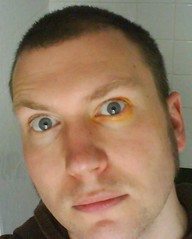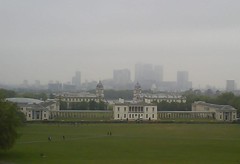I'm off to Hungary next week for a brother's wedding. Spent a weekend in Budapest for my stag do five years ago, have drunk some good Tokay and I've also seen
Countess Dracula, but otherwise don't know a great deal about the country.
So my soon-to-be sister-in-law leant me
Egri csillagok – or, in English,
Eclipse of the Crescent Moon, A tale of the siege of Eger, 1552 – by Géza Gárdonyi. First serialised in the
Pesti Hirlap newspaper from Christmas 1899, the edition I read was translated into English by George F Cushing in 1991.
Wikipedia summarises the five sections of the book, which begins with two children, Gergely and Éva, being kidnapped by some villainous Turks. Gergely is clever and he and Éva escape. Years later, when Buda has been taken by the Turks, they meet up again and get married, have some adventures before getting caught up in
Eger as it's besieged by an army of 200,000.
It's a rich and patriotic story, full of incident and fun characters. The Hungarian heroes are a lesson in most noble bravery; they're resourceful, canny and honest. Báliant Török, for example, finds dealing with the dishonest Turks hard work: “I'm not used to hiding my thoughts from other people,” (p. 182). Szalkay, meanwhile, knows who to shake hands with: “His practised eye told him [Miklós Réz] was not a gentleman,” (p. 425). During the siege itself there's a merry discussion of cutlery and recipes (pp. 426-7), and plenty of good-natured jokes.
When one naughty fellow, Hegedüs, is caught trying to negotiate with the enemy, he gets an unquestionably fair trial: Zoltay is even relieved of his duties as a judge for flaring up in anger. As Hegedüs swings from a gibbet we're left under no doubt that this is a sterling, civilised bunch.
There aren't a lot of shades of grey. The Turks are variously greedy, cruel, cowardly, sneaky, dishonest and hypocritical (yet apparently still better to live under than the Austrians). In general, it reminded me a lot of
The Horse and his Boy. If I'd understood
Edward Said's impenetrable prose (I think he's sort of saying the same things as
Tusk Tusk), I might dare to call it Orientalist.
It's not as if the Turks can do anything right: they're mocked if they break their vow of abstinence of alcohol, and mocked if they stick with it. The new bey is described as,
“a coward and a fool ... Can someone brought up on water be anything else?”Géza Gárdonyi, Eclipse of the Crescent Moon, p. 271.
(It's a little like the Russians of the 1950s, as described in
Edward Wilson's novel, The Envoy. The Russians won't trust those who aren't boozers, so spies learn to line their stomachs by drinking olive oil.)
When our heroes dare visit the Turk's own lands, there's a lot of wide-eyed pointing and gawping. As with the boozing, the Turk's odd behaviour gives clues to Hungarian norms:
“Constantinople is a paradise for dogs. There are no courtyards here, or if there is anything like that, it is on the roof of the house, so there is no room anywhere for dogs. Those red-haired, fox-like creatures swarm in hundreds through the streets in some parts. The Turks do not disturb them; indeed, when one or other of them has a litter of puppies, they throw down rags or a bit of rush-matting by the gate to help them. Those dogs keep Constantinople clean and tidy. Each morning the Turks empty the square tin dustbins beside their gate. The dogs eat the contents. They devour everything except iron and glass. And the dogs are not ugly or wild either. You can pat any of them, and they will wag their tail with delight. There is not one of them that is not glad to be stroked.”Ibid., p. 254.
So in Hungary the dogs are wild and ugly, and shooed out of sight. No wonder its such a surprise to find them being friendly. I assume as well as eating the rubbish, the dogs helped keep down the plague.
Yet the book also pokes fun at the ignorance of its heroes. There's a glimpse of a map depicting,
“the three continents. (At that time scholars had not yet mapped out the land of Columbus; there was merely a rumour that the Portuguese had discovered a hitherto unknown continent. But nobody knew how much truth there was in it. And even Columbus had not yet even dreamt of Australia.)”Ibid., p.110.
That's in Part II, set in 1541 – 50 years after Columbus stumbled into America. I wonder how long it took for word to get round?
Or there's the moment our heroes are shocked to hear from one spy of the bey's habit of drinking ink:
“'What?'
'Ink. He drinks ink like we do wine, sir. Morning, noon and night he drinks nothing but ink.'
'Come off it! It can't be ink.'
'Oh, but it is ink, sir, good genuine black ink. They make it out of some kind of bean, and it's so bitter that I was still spitting it out the day after when I tasted it. And in Turkish the name of the bean is kahve.'”Ibid., 349.
For all the book protests, the Hungarians and Turks don't half overlap. The stealing of children – as seen in Part I – is a reasonably common occurrence, and there are numerous instances of people who've swapped sides and / or forgotten their heritage. Though the author prefers not to point it out, there are examples of noble Turks and of lazy, good-for-nothing Hungarians.
Further muddying the water, the Hungarian and Turkish languages are also very similar, as Jancsi explains:
“'Well, for example: elma = alma [apple], benim = enyim [mine], baba = papa, papuch = papucs [slippers], daduk = duda [bagpipes] chagana...'
'Csákány [axe]!' cried Eva, clapping.”Ibid., pp. 227-8.
This suggests the cultures have been mixing for centuries. I gather Hungarian is a Uralic language and shares roots with Finnish and Estonian, while a chum in the pub says its also been linked as far as Japanese.
(
T Majlath compares Hungarian and Japanese words, but is also keen to state that these are only “similarities” ... “Nowhere do I claim that Magyar (Hungarian) is related to Basque, Etruscan, Japanese, Sanskrit, Sumerian, or Martian or whatever. I wouldn't dare to make such claims which are, after all, the sole prerogatives of Indo-European.”)
There are plenty of fun observations throughout. Zoltay is described as “a jolly man without a beard, so he was unmarried,” (p. 301). Later there's an example of a Christian not quite living the spirit of his order.
“The office of bishop isn't only an ecclesiastical post, but a military one, too. Every bishop has his own troops. And every bishop is also a captain.”Ibid., p. 360.
When we get to the siege itself, there's plenty to be said on tactics, experience and intelligence in war. There's stuff about when best to fire on the enemy and how to check if they're trying to mine under the castle.
“Get the drummers to put their drums on the ground too and spread peas on them ... Go round all the sentries and tell them to examine the drums and dishes [of water] each time they pass them. As soon as there's any movement of water in the dishes or peas and shot on the drums, they're to report immediately.”Ibid., p. 450.
You also feel the historical moment, as new technologies threaten the old ways of warfare. On page 325, Cecey declares that, “A good bow is worth more than any rifle.” Yet 50 pages later we're told that gunfire is in the Hungarians' blood:
“Ever since the discovery of gunpowder, Eger more than any other place in the world had resounded to the noise of firing. Even today spring festivals, firemen's parties, elections, choir celebrations, garden parties and public performances are inconceivable without being preceded by gunfire. The gun is a substitute for the poster. Sometimes there are posters too, but all the same they do not dispense with the gun. In the fortress there are always a few mortars lying around in the grass. Anyone who likes fires them. So how could the folk of Eger feel afraid?”Ibid., p. 367.
As the siege continues, these folk of Eger have to roll their sleeves up. It's a great bit of patriotic fervour – like the ordinary citizens who help Spider-Man or Batman. It's also thrillingly blood-thirsty:
“Mrs Gáspár Koscis, a sturdy figure, drenches an approaching aga with a long bear so thoroughly with boiling water that when he makes a grab at his beard it comes away in his hand. Another woman seizes a flaming log from the nearby fire and strikes a Turk in the face with it so that sparks fly fly from it in all directions. The other women repulse the pagans with weapons.
'Jesus, help us!'
'Strike them! Strike them!' roars the smith from Felnémet.
He rushes with his hammer in among the women. Three Turks are fighting there back to back. He strikes one so hard on the head that his brains spatter out his nose and ears.”Ibid., pp. 536-7.
The all-important differences between the Hungarians and Turks also play their part:
“Actually it was the soup that beat off the attack. The Turks had got used to fire, sword and pike, but knew hot soup only in spoons. As the boiling paprika-spiced liquid poured down the first ladder, the men seemed to be swept off it. The swarm of men at the foot of the ladders also jumped away. Some clutched at their hands, others their faces, others their necks. Covering their heads with their shields they backed away from the walls cursing.”Ibid p. 478.
As the odds continue to stack up against our plucky heroes, it gets ever more gripping. Who lives? Who dies? Who will the siege?
George Cushing's introduction talks about Gárdonyi's research and what bits of the story he's invented, and I'm looking forward to seeing the real castle for myself next week. But I'm also impressed by how Gárdonyi scoffs his cake and keeps it for the historical record. Because while we get a happy ending for Gergely and Eva, satisfying the romantic feel of the thing, the real history sits heavy on them; they've only won a reprieve.
But way, way back it's let us know Gergely's not so brilliant future. One reason for Gergely visiting Constantinople in Part III is so the author can let us in on what's to befall him.
“When you've grown into a fine bearded man and a gentleman, that's where the wicked Turks will entice you into a trap and clap your hands and feet in irons! And only death will release you from them...”Ibid., pp. 228-9.
And again later:
“Poor young hero! You bright star of the Hungarian galaxy, you will never turn grey on this earth! With what expression, I wonder, would you look into the mirror of the future if some divine hand displayed it for you, and you were to see yourself in captive's chains in this very spot, and you were to see the Turkish hangman knotting the rope for you round that rusty lamp-bracket!...”Ibid., p. 272.
It's a nice cheat round the problem of historical fiction, where the author struggles to make us care about what's going to happen to characters who must be long dead.
 Big Finish have announced that my book, Bernice Summerfield - The Inside Story, will be out in August. Pre-order it NOW and get your copy signed by me and Lisa Bowerman.
Big Finish have announced that my book, Bernice Summerfield - The Inside Story, will be out in August. Pre-order it NOW and get your copy signed by me and Lisa Bowerman.









